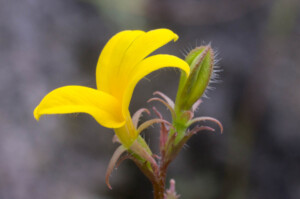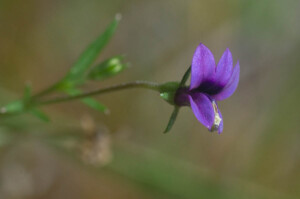Monopsis is a genus closely related to Lobelia. It is a small genus of about 13 species confined to sub-Saharan Africa of which 8 are found in the Cape. All the species form small herbaceous plants with colourful flowers. There are two species in the Klein River Mountains, Monopsis lutea and Monopsis simplex, and both are found at Phillipskop. Providing you have identified them as a Monopsis, the two species are easily told apart. Monopsis lutea has large pure yellow flowers, while Monopsis simplex has flower less than half the size of Monopsis lutea, and are deep purple with an even darker spot in the throat.
The genus Monopsis have flowers that look like an upside-down Lobelia. That is they have three lobes on the top of the flower and two on the bottom that are split in the middle. This is opposed to Lobelia that has 3 lobes on the bottom and two split ones on the top. However, it is actually the Lobelia flowers that are upside-down, or using the correct botanical term, they are resupinate. This means that the flower stalk twists during development 180° so that the lower side is now on the top. In Monopsis, the flower stalks are not twisted and therefore the right way up.
The flowers of Lobelia are irregular, that is they have some petals pointing upwards and some petals pointing downwards. This makes them bilaterally symmetric when viewed face on. Richard Salisbury, who first coined the name Monopsis in 1812, regarded this arrangement as having “two-faces, if I may use the expression, one pointing backwards, the other forwards”. When he described his new genus Monopsis, he noted that it had “one face”. In other words, the flowers were regular, where the petals are all similar in shape and size and the whole flower is radially symmetric or actinomorphic. The genus was named to reflect this: mono means one in Greek, and opsis a face. The sole species in his new genus was Monopsis debilis (at the time called Monopsis conspicua). Unfortunately, Monopsis debilis is a peculiarity as it is the only species in the genus with regular flowers. Every other species in the genus, including Monopsis lutea and Monopsis simplex, have irregular flowers. They are not one-faced but two-faced.
Both species found in the Klein River Mountain grow in damp areas. Monopsis lutea trails along the ground in areas that are seasonally damp, while Monopsis simplex appears to prefer permanently moist sand found alongside streams. While both have beautiful flowers close-up, the ones of Monopsis simplex are too small and scattered to make a significant display in a garden. Monopsis lutea however is a good garden plant if it gets enough sun and moisture, providing effective ground cover and a multitude of bright happy yellow faces over a long period.









